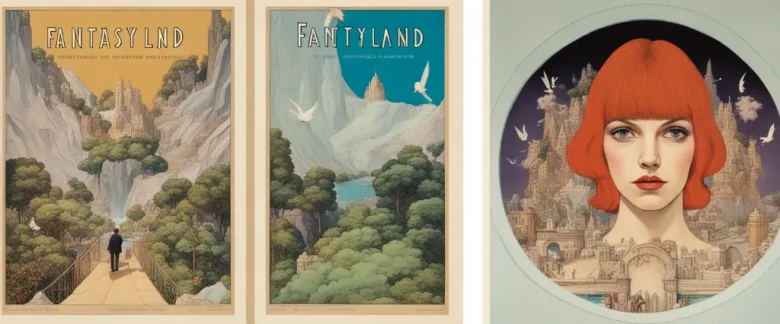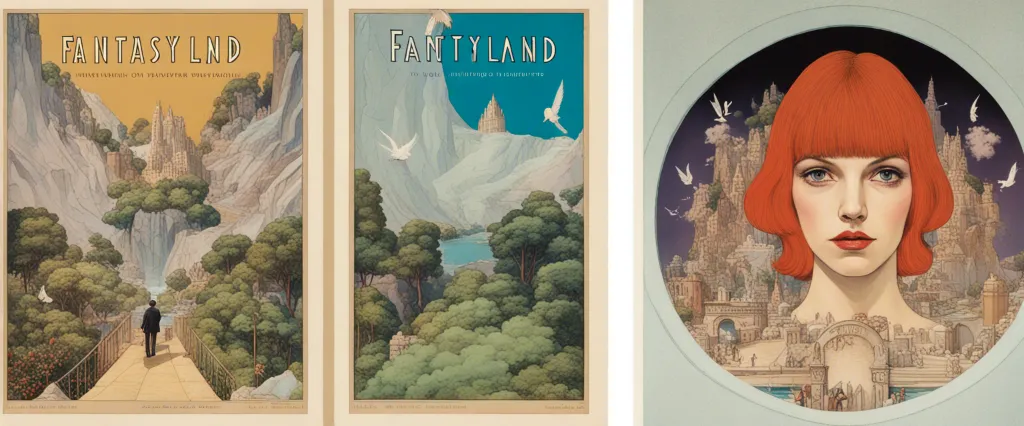In his book “Fantasyland,” Kurt Andersen explores the history of American culture and the rise of a uniquely American form of belief in the fantastic. As a bestselling author and acclaimed journalist, Andersen has delved into the intersection of politics and culture in America for decades, offering keen insights into the forces driving our society. Through “Fantasyland,” Andersen examines the roots of America’s obsession with conspiracy theories, magical thinking, and self-invention, providing a compelling analysis of how these phenomena have shaped our national identity.
Chapter 1: Introduction to the history and culture of American fantasy.
In Chapter 1 of “Fantasyland” by Kurt Andersen, the author provides an introduction to the history and culture of American fantasy. Andersen argues that America has a unique relationship with fantasy compared to other cultures, stemming from its foundation on the pursuit of religious freedom and the belief in self-determination. He suggests that this mindset has led to a culture where fantastical thinking is not only accepted but often celebrated.
Andersen traces the history of American fantasy from the early settlers who believed in manifest destiny and the idea of a “new world” to the proliferation of conspiracy theories, UFO sightings, and the rise of Hollywood blockbusters. He examines how key events such as the Salem witch trials, the Civil War, and the countercultural movements of the 1960s have shaped American attitudes towards the fantastical.
The chapter also delves into the role of technology and the media in perpetuating fantasies, as well as the impact of social media and the internet on the spread of misinformation. Andersen raises important questions about the consequences of living in a society where fantasy often takes precedence over reality, and how this may shape the future of American culture and society.
Chapter 2: Exploration of the roots of magical thinking in American society.
In Chapter 2 of Fantasyland, Kurt Andersen delves into the history and development of magical thinking in American society. He explores how the early European settlers, driven by religious beliefs and the desire for economic prosperity, brought with them a mindset that prioritized faith over reason. This mindset laid the groundwork for the proliferation of various movements and ideologies in America, such as Puritanism, transcendentalism, and spiritualism, that embraced fantastical beliefs and practices.
Andersen discusses the role of charismatic leaders and opportunists who capitalized on America’s fertile soil for magical thinking, from P.T. Barnum’s hoaxes and spectacles to the rise of New Age spirituality in the 20th century. He also examines the impact of technological advancements and the media on the spread of supernatural beliefs, conspiracy theories, and pseudoscience in American culture.
Through historical examples and analysis, Andersen illustrates how America’s unique blend of individualism, religious fervor, and lack of a centralized authority has contributed to the flourishing of magical thinking in the country. He suggests that this culture of fantasy and belief in the extraordinary has influenced various aspects of American life, from politics and entertainment to consumerism and self-help movements.
Chapter 3: Examination of the rise of conspiracy theories and alternative realities.
In Chapter 3 of “Fantasyland” by Kurt Andersen, the author examines the rise of conspiracy theories and alternative realities in American history. Andersen traces the roots of conspiracy theories back to the Founding Fathers and argues that America has always had a penchant for believing in outlandish ideas. He discusses the role of religious zealotry, anti-intellectualism, and the self-reliant individualism that have fueled the proliferation of conspiracy theories in the United States.
Andersen explores how the rise of mass media, the internet, and social media platforms have provided a breeding ground for conspiracy theories to flourish. He argues that the democratization of information has led to a fragmentation of reality, where individuals can choose their own truths and create their own alternative narratives.
The chapter delves into various conspiracy theories and alternative realities that have gained traction in American society, from beliefs in government cover-ups to claims of alien abductions. Andersen stresses the importance of critical thinking and skepticism in a time where misinformation and disinformation are rampant.
Overall, Chapter 3 of “Fantasyland” highlights the ways in which Americans have embraced conspiracy theories and alternative realities as a form of escapism and self-delusion. Andersen raises important questions about the consequences of living in a world where fantasy often trumps reality.
Chapter 4: Analysis of the influence of entertainment and mass media on belief systems.

In Chapter 4 of “Fantasyland” by Kurt Andersen, the author explores the impact of entertainment and mass media on belief systems in America. Andersen argues that the rise of mass media and entertainment in the 20th century has played a significant role in shaping and influencing the beliefs and values of the American public.
One of the key themes in this chapter is the idea that entertainment and media have blurred the lines between reality and fantasy, leading to a culture where belief in the fantastical and the irrational is increasingly normalized. Andersen argues that this shift has fueled a culture of conspiracy theories, fake news, and fringe beliefs that challenge traditional notions of reality.
Additionally, Andersen discusses how entertainment and media have been used as tools to manipulate and control public opinion, often promoting consumerism, political agendas, and societal norms. He also delves into the ways in which entertainment and media have been used to shape religious beliefs and practices, as well as the rise of cults and new religious movements that have emerged as a result of these influences.
Overall, Chapter 4 of “Fantasyland” offers a thought-provoking analysis of the pervasive influence of entertainment and mass media on belief systems in America, highlighting the ways in which these forces shape our collective understanding of reality and truth.
Chapter 5: Discussion on the blurred lines between fact and fiction in contemporary culture.
In Chapter 5 of “Fantasyland” by Kurt Andersen, the discussion focuses on the increasing difficulty in distinguishing between fact and fiction in contemporary culture. Andersen argues that America has always had a tendency towards believing in fantastical ideas and myths, but this tendency has been exacerbated by the rise of digital technology and social media. These platforms have made it easier for misinformation and conspiracy theories to spread quickly and widely, blurring the lines between reality and fantasy.
Andersen delves into the ways in which modern society has become more susceptible to magical thinking and delusional beliefs, with many people embracing alternative facts and rejecting established truths. He explores how this culture of fantasy has been fueled by politicians, media figures, and celebrities who peddle lies and distortions in order to manipulate public opinion.
Ultimately, Andersen warns of the dangers of living in a society where facts are malleable and truth is subjective. He calls for a return to rationality and critical thinking in order to combat the proliferation of misinformation and conspiracy theories that threaten to undermine democracy and erode trust in institutions.
Chapter 6: Reflections on the impact of technology and social media on fantasy proliferation.
In Chapter 6 of “Fantasyland” by Kurt Andersen, the author reflects on the impact of technology and social media on the proliferation of fantasy in society. Andersen discusses how advancements in technology have made it easier for individuals to consume and share fantasies through various platforms, including social media. These platforms have created an environment where individuals can easily access and distribute information, allowing fantasies to spread more rapidly and widely than ever before.
Andersen also examines the role of social media in shaping and perpetuating personal fantasies, as individuals can curate their online personas and create idealized versions of themselves. This phenomenon has led to a blurring of the lines between reality and fantasy, as individuals can manipulate their online presence to fit their desired narrative.
Furthermore, Andersen explores how technology has influenced the way we consume media and entertainment, allowing us to immerse ourselves in virtual worlds and escape from reality. This has contributed to the growing trend of individuals seeking out fantastical and exaggerated versions of reality, ultimately leading to a society that is increasingly driven by fantasy.
Overall, Chapter 6 delves into the ways in which technology and social media have shaped the proliferation of fantasy in society, blurring the lines between reality and imagination. Andersen explores the consequences of this phenomenon and raises important questions about the impact of living in a world where fantasy is increasingly pervasive.
Chapter 7: Critique of the commodification of fantasy and its effects on society.
In Chapter 7 of “Fantasyland” by Kurt Andersen, the author delves into the commodification of fantasy and its impact on society. He argues that the consumer culture in America has profited immensely from the selling of illusions and fantasies to the masses. Andersen discusses how entertainment industries, such as Hollywood and the the self-help industry, have capitalized on people’s desire for escapism, selling them on the idea that they can achieve their wildest dreams if they just buy into their products.
Andersen also explores the detrimental effects of this commodification of fantasy on society. He highlights how the relentless pursuit of happiness and material success through fantasy has contributed to a culture of narcissism, entitlement, and a detachment from reality. This, in turn, has fueled a sense of disconnection and distrust among individuals and a deepening divide in society.
Overall, Andersen critiques the manipulation of fantasy for profit and the resulting consequences it has on society, urging readers to consider the implications of living in a culture where fantasy is sold as reality. He challenges readers to question the impact of living in a world where illusion is valued over truth and how this perpetuates a cycle of dissatisfaction and discord in society.

Chapter 8: Call for a reassessment of the role of fantasy in shaping American identity.
Chapter 8 of Kurt Andersen’s book “Fantasyland” calls for a reassessment of the role of fantasy in shaping American identity. Andersen argues that the tradition of embracing fantastical beliefs and rejecting reality has had a significant impact on American culture and politics. He traces the roots of this phenomenon back to the country’s founding, referencing the Puritans, who believed in supernatural occurrences and saw themselves as chosen by God.
Andersen examines how this mindset has evolved over time, leading to the proliferation of conspiracy theories, pseudoscience, and religious fundamentalism in modern American society. He discusses the influence of storytelling, entertainment, and technology in perpetuating these beliefs, noting that the line between fantasy and reality has become increasingly blurred.
Ultimately, Andersen suggests that Americans need to be more discerning in their acceptance of fantastical ideas and narratives. He argues that a healthy dose of skepticism and critical thinking is needed to combat the spread of misinformation and distortion of truth. By reassessing the role of fantasy in shaping American identity, Andersen believes that society can move towards a more rational and realistic understanding of the world.
After Reading
In “Fantasyland,” Kurt Andersen explores the history of America’s obsession with fantasy, from the puritanical settlers to the present day, where reality and illusion are often indistinguishable. He argues that this culture of unreality has shaped the nation’s politics, religion, and economy, leading to a society where belief in the fantastical is often valued more than facts. Andersen’s examination of this phenomenon is thought-provoking and timely, shedding light on how America’s unique relationship with fantasy has influenced its identity and cultural landscape.
1. “American Gods” by Neil Gaiman – This novel explores the collision of myths, legends, and gods in modern America, blending fantasy with reality in a similar way to Fantasyland.
2. “The Gospel of the Flying Spaghetti Monster” by Bobby Henderson – This satirical book humorously critiques organized religion and the nature of belief systems, similar to the exploration of American’s obsession with irrational beliefs in Fantasyland.
3. “Confessions of an Economic Hitman” by John Perkins – This non-fiction book delves into the manipulation of global economics and politics, shedding light on how power and greed shape our world in a way that aligns with the themes of Fantasyland.
4. Sapiens: A Brief History of Humankind” by Yuval Noah Harari – This book offers a sweeping history of human civilization, examining the cultural, societal, and psychological factors that have shaped human beliefs and behaviors throughout history.
5. “The Age of American Unreason” by Susan Jacoby – This book explores the decline of critical thinking and intellectualism in American society, critiquing the irrational and anti-intellectual tendencies that Fantasyland also examines.




